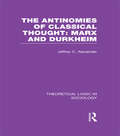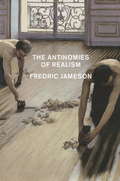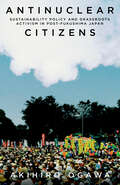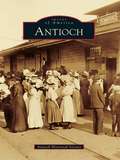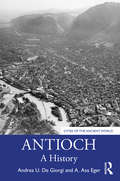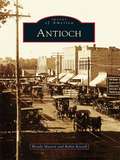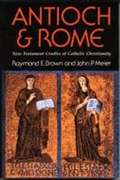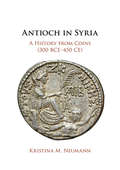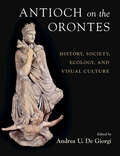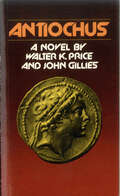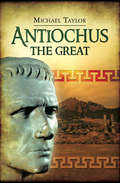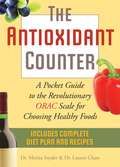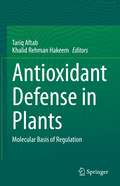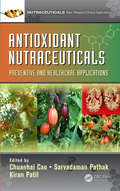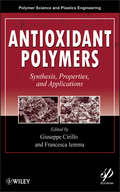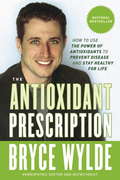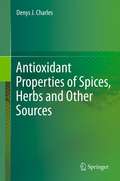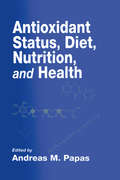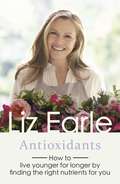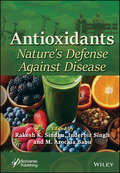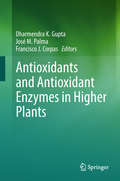- Table View
- List View
The Antinomies of Classical Thought: Marx And Durkheim (Theoretical Logic in Sociology)
by Jeffrey C. AlexanderThis volume challenges prevailing understanding of the two great founders of sociological thought. In a detailed and systematic way the author demonstrates how Marx and Durkheim gradually developed the fundamental frameworks for sociological materialism and idealism. While most recent interpreters of Marx have placed alienation and subjectivity at the centre of his work, Professor Alexander suggests that it was the later Marx’s very emphasis on alienation that allowed him to avoid conceptualizing subjectivity altogether. In Durkheim’s case, by contrast, the author argues that such objectivist theorizing informed the early work alone, and he demonstrates that in his later writings Durkheim elaborated an idealist theory that used religious life as an analytical model for studying the institutions of secular society.
The Antinomies Of Realism
by Fredric JamesonThe Antinomies of Realism is a history ofthe nineteenth-century realist novel and its legacy told without a glimmer of nostalgia for artistic achievements that the movement of history makes it impossible to recreate. The works of Zola, Tolstoy, Pérez Galdós, and George Eliot are in the most profound sense inimitable, yet continue to dominate the novel form to this day. Novels to emerge since struggle to reconcile the social conditions of their own creation with the history of this mode of writing: the so-called modernist novel is one attempted solution to this conflict, as is the ever-more impoverished variety of commercial narratives - what today's book reviewers dub "serious novels," which are an attempt at the impossible endeavor to roll back the past. Fredric Jameson examines the most influential theories of artistic and literary realism, approaching the subject himself in terms of the social and historical preconditions for realism's emergence. The realist novel combined an attention to the body and its states of feeling with a focus on the quest for individual realization within the confines of history. In contemporary writing, other forms of representation - for which the term "postmodern" is too glib - have become visible: for example, in the historical fiction of Hilary Mantel or the stylistic plurality of David Mitchell's novels. Contemporary fiction is shown to be conducting startling experiments in the representation of new realities of a global social totality, modern technological warfare, and historical developments that, although they saturate every corner of our lives, only become apparent on rare occasions and by way of the strangest formal and artistic devices.In a coda, Jameson explains how "realistic" narratives survived the end of classical realism. In effect, he provides an argument for the serious study of popular fiction and mass culture that transcends lazy journalism and the easy platitudes of recent cultural studies.From the Hardcover edition.
Antinuclear Citizens: Sustainability Policy and Grassroots Activism in Post-Fukushima Japan (Anthropology of Policy)
by Akihiro OgawaFollowing the Great East Japan Earthquake on March 11, 2011, tsunamis engulfed the Fukushima Daiichi nuclear power plant located on Japan's Pacific Coast, leading to the worst nuclear disaster the world has seen since the Chernobyl crisis of 1986. Prior to this disaster, Japan had the third largest commercial nuclear program in the world, surpassed only by those in the United States and France—nuclear power significantly contributed to Japan's economic prosperity, and nearly 30% of Japan's electricity was generated by reactors dotted across the archipelago, from northern Hokkaido to southern Kyushu. This long period of institutional stasis was, however, punctuated by the crisis of March 11, which became a critical juncture for Japanese nuclear policymaking. As Akihiro Ogawa argues, the primary agent for this change is what he calls "antinuclear citizens"— a conscientious Japanese public who envision a sustainable life in a nuclear-free society. Drawing on over a decade of ethnographic research conducted across Japan—including antinuclear rallies, meetings with bureaucrats, and at renewable energy production sites—Ogawa presents an historical record of ordinary people's actions as they sought to survive and navigate a new reality post-Fukushima. Ultimately, Ogawa argues that effective sustainability efforts require collaborations that are grounded in civil society and challenge hegemonic ideology, efforts that reimagine societies and landscapes—especially those dominated by industrial capitalism—to help build a productive symbiosis between industry and sustainability.
Antioch
by Antioch Historical SocietyWhen the first settlers arrived here in 1850, they could never have guessed that their tiny settlement would one day be home to over 100,000 souls, scores of factories, and the gateway to the California Delta with some of the most productive agricultural lands in the world. In earlier days, the Sacramento and San Joaquin Rivers were the main routes into the state's interior, as the swampy delta land had yet to be tamed. Antioch and nearby Pittsburg served as major depots for supplies to the Sierra gold fields, stockpiling lumber, produce, hay, dry goods, medicine, and fuel from the Stewartville, Empire, and Judsonville coal mines. Named in 1851 after the biblical city in Syria, this town served for many years as the Bay Area's easternmost outpost and provided its inhabitants with a bounty both man-made and natural.
Antioch: A History (Cities of the Ancient World)
by Andrea U. De Giorgi A. Asa EgerThis is a complete history of Antioch, one of the most significant major cities of the eastern Mediterranean and a crossroads for the Silk Road, from its foundation by the Seleucids, through Roman rule, the rise of Christianity, Islamic and Byzantine conquests, to the Crusades and beyond. Antioch has typically been treated as a city whose classical glory faded permanently amid a series of natural disasters and foreign invasions in the sixth and seventh centuries CE. Such studies have obstructed the view of Antioch’s fascinating urban transformations from classical to medieval to modern city and the processes behind these transformations. Through its comprehensive blend of textual sources and new archaeological data reanalyzed from Princeton’s 1930s excavations and recent discoveries, this book offers unprecedented insights into the complete history of Antioch, recreating the lives of the people who lived in it and focusing on the factors that affected them during the evolution of its remarkable cityscape. While Antioch’s built environment is central, the book also utilizes landscape archaeological work to consider the city in relation to its hinterland, and numismatic evidence to explore its economics. The outmoded portrait of Antioch as a sadly perished classical city par excellence gives way to one in which it shines as brightly in its medieval Islamic, Byzantine, and Crusader incarnations. Antioch: A History offers a new portal to researching this long-lasting city and is also suitable for a wide variety of teaching needs, both undergraduate and graduate, in the fields of classics, history, urban studies, archaeology, Silk Road studies, and Near Eastern/Middle Eastern studies. Just as importantly, its clarity makes it attractive for, and accessible to, a general readership outside the framework of formal instruction.
Antioch
by Wendy Maston Robin KessellAntioch is a unique small town at the border between Illinois and Wisconsin. Its rich history and strong family values have supported the village since the first families arrived in the early 1800s. In 1983, a group of dedicated people decided the history of Antioch was slipping away and started the Lakes Region Historical Society. Since that time the community has responded with thousands of artifacts and pictures of early Antioch. From the humble beginnings in log cabins along the shores of Loon Lake to the active community of today, the pictures lead one back in time. Antioch blossomed during the 1890s and early 1900s when the Chicago area discovered the beauty of the lakes in the region.Resorts opened everywhere, almost overnight it seemed, and crowds flooded the area. Most came on the train; others came in the new horseless carriages. The village of Antioch expands way beyond its legal limits. The surrounding area depends on the village for much of its needs. The lakes still thrive today because of the workings of the little town. Although the population is only in the thousands, the unincorporated area swells that number to double its size.
Antioch and Rome: New Testament Cradles of Catholic Christianity
by Raymond E. Brown John P. MeierTwo prominent New Testament scholars attempt to draw pictures of two of the most important centers of first century Christianity: Antioch and Rome. You will think of Christianity's origins differently when you read this book.
Antioch in Syria: A History from Coins (300 BCE–450 CE)
by Kristina M. NeumannAntioch in Syria critically reassesses this ancient city from its Seleucid foundation into Late Antiquity. Although Antioch's prominence is famous, Kristina M. Neumann newly exposes the gradations of imperial power and local agency mediated within its walls through a comprehensive study of the coins minted there and excavated throughout the Mediterranean and Middle East. Patterns revealed through digital mapping and Exploratory Data Analysis serve as a significant index of spatial politics and the policies of the different authorities making use of the city. Evaluating the coins against other historical material reveals that Antioch's status was not fixed, nor the people passive pawns for external powers. Instead, as imperial governments capitalised upon Antioch's location and amenities, the citizens developed in their own distinct identities and agency. Antioch of the Antiochians must therefore be elevated from traditional narratives and static characterisations, being studied and celebrated for the dynamic polis it was.
Antioch on the Orontes: History, Society, Ecology, and Visual Culture
by De Giorgi, Andrea U.Antioch on the Orontes was one of the most important cities of the ancient Mediterranean world. A hinge between the Mediterranean, Central Asia, and the Far East, its commercial and cultural prominence spanned centuries, from its Seleucid foundation to the Islamic conquest and beyond. This volume offers an archaeological and historical overview of Antioch from its origins through late antiquity. Drawing on a vast body of modern research, it explores the city's built environment, the institutions that shaped it in fundamental ways, intellectual currents, and ecological setting. Significantly, analysis of Antioch's defining ecology is incorporated into accounts of imperial building programs, religious rifts, and the agency of the local community. The study also foregrounds the cultural responses to the environmental downturns and disasters that have continually wreaked havoc on the city. At its center is the Antiochene population, whose fierce determination enabled the city to overcome repeated episodes of desolation and destruction.
Antiochus: A Novel
by Walter Price John GilliesHe was one of the most notorious persecutors of the Jews who ever lived. He defiled the Temple of God, killed religious zealots, and became the archetype of the Antichrist.The Greek monarch, King Antiochus IV Epiphanes, ruled the ancient Seleucid Empire 2200 years ago. The authors have written the story of his reign and find an extremely revealing relationship between this mysterious personality and certain events that the Bible indicates are yet to come to pass.An important evil figure in Bible prophecy comes to life in Antiochus.
Antiochus: A Novel
by Walter Price John GilliesHe was one of the most notorious persecutors of the Jews who ever lived. He defiled the Temple of God, killed religious zealots, and became the archetype of the Antichrist.The Greek monarch, King Antiochus IV Epiphanes, ruled the ancient Seleucid Empire 2200 years ago. The authors have written the story of his reign and find an extremely revealing relationship between this mysterious personality and certain events that the Bible indicates are yet to come to pass.An important evil figure in Bible prophecy comes to life in Antiochus.
Antiochus and Peripatetic Ethics (Cambridge Classical Studies)
by Georgia TsouniThis book offers a fresh analysis of the account of Peripatetic ethics in Cicero's On Ends 5, which goes back to the first-century BCE philosopher Antiochus of Ascalon. Georgia Tsouni challenges previous characterisations of Antiochus' philosophical project as 'eclectic' and shows how his reconstruction of the ethics of the 'Old Academy' demonstrates a careful attempt to update the ancient heritage, and predominantly the views of Aristotle and the Peripatos, in the light of contemporary Stoic-led debates. This results in both a hermeneutically complex and a philosophically exciting reading of the old tradition. A case in point is the way Antiochus grounds the 'Old Academic' conception of the happy life in natural appropriation (oikeiosis), thus offering a naturalistic version of Aristotelian ethics.
Antiochus the Great
by Michael TaylorThe story of the man who ruled a sprawling ancient empire and strove to defend it against the Roman Republic. A teenage king in 223 BC, Antiochus III inherited an empire in shambles, ravaged by civil strife and eroded by territorial secessions. But he proved himself a true heir of Alexander—defeating rebel armies and embarking on a campaign of conquest and reunification. Although repulsed by Ptolemy IV at the Battle of Raphia, his eastern campaigns reaffirmed Seleucid hegemony as far as modern Afghanistan and Pakistan. Returning westward, he defeated Ptolemy V at Panion and succeeded in adding Koile Syria to the Seleucid realm. At the height of his powers, he challenged growing Roman power, unimpressed by their recent successes against Carthage and Macedon. His expeditionary force was crushed at Thermopylae and evacuated. Refusing to bow before Roman demands, Antiochus energetically mobilized against Roman invasion, but was again decisively defeated at the epic battle of Magnesia. Despite the loss of territory and prestige enshrined in the subsequent Peace of Apamea, Antiochus III left the Seleucid Empire in far better condition than he found it. Although sometimes presented as a failure against the unstoppable might of Rome, Antiochus III must rank as one of the most energetic and effective rulers of the ancient world. This book narrates his eventful career—and examines Seleucid military organization and royal administration.
The Antioxidant Counter: A Pocket Guide to the Revolutionary ORAC Scale for Choosing Healthy Foods
by Mariza Snyder Lauren ClumSUPERCHARGE YOUR DIET WITH ANTIOXIDANT-PACKED FOODSBased on the groundbreaking ORAC (Oxygen Radical Absorbance Capacity) scale, this handy guide presents easy-to-understand antioxidant scores for hundreds of foods. It's specially designed to show which nutrition-loaded foods offer the greatest healing power and how to include more of them in your diet. Clear, Easy-to-Read Charts Delicious, Antioxidant-Rich Recipes Explanation of ORAC Scores Check the book's charts for yourself and see how an appleCheck the book's charts for yourself and see how an apple gives you five times the antioxidants of a banana! Or how topping pasta with broccoli and bell peppers instead of zucchini and tomato offers an amazing ten-fold increase.
Antioxidant Defense in Plants: Molecular Basis of Regulation
by Tariq Aftab Khalid Rehman HakeemThis edited book highlights the molecular basis of various enzymatic and non-enzymatic antioxidants, defense mechanisms and adaptation strategies employed by plants to avoid the stressful conditions. Special focus is given to gene expression, omics and other latest technologies such as CRISPR-Cas mediated genome editing applications for defense related studies in plants. Environmental stresses such as drought, salinity or floods etc. induce the generation of reactive oxygen species (ROS) which causes severe damage to cell membrane integrity by accelerating lipid peroxidation. To counteract the detrimental effect of ROS, plants are inherited with an intricate and vibrant antioxidant defense system, comprised of enzymatic (catalase, peroxidase, superoxide dismutase, glutathione reductase, glutathione S-transferase, guaiacol peroxidase, monodehydroascorbate reductase, dehydroascorbate reductase etc.), and non-enzymatic (glutathione, ascorbate, α-tocopherol, carotenoids, flavonoids etc.) antioxidants, which scavenge and/or reduce excess ROS and improve plant tolerance to various stresses. Stress tolerance in most crop plants is positively correlated with an efficient antioxidant system. Therefore, studying the efficiency of antioxidant defense systems in plants is necessary for facilitating the plant’s nature of adaptation against challenging environments. This book is of interest to teachers, researchers and academic experts. Also, the book serves as additional reading material for undergraduate and graduate students of biotechnology and molecular biology of plants.
Antioxidant Nutraceuticals: Preventive and Healthcare Applications (Nutraceuticals)
by Chuanhai Cao Sarvadaman Pathak Kiran PatilThis book addresses various clinical and sub clinical applications of antioxidant nutraceuticals, with a primary focus on preventive use for general wellness, common ailments, and such chronic illnesses as cancer and neurological applications. This unique book captures the applications of natural antioxidants, which have been used for thousands of years in Traditional Chinese Medicine and Ayurvedic Medicine as well as modern nutraceuticals formulations. It covers antioxidant applications in clinical scenarios including the historical perspective, basic antioxidant properties and applications, anti-inflammatory properties, and antioxidant applications in a variety of clinical conditions.
Antioxidant Polymers
by Giuseppe Cirilo Francesca IemmaAntioxidant Polymers is an exhaustive overview of the recent developments in the field of polymeric materials showing antioxidant properties. This research area has grown rapidly in the last decade because antioxidant polymers have wide industry applications ranging from materials science to biomedical, pharmaceuticals and cosmetics.
The Antioxidant Prescription: How to Use the Power of Antioxidants to Prevent Disease and Stay Healthy for Life
by Bryce WyldeDr. Bryce Wylde, one of Canada's most popular and respected health care practitioners, gives us individualized step-by-step treatment plans to fight disease and stay healthy.In The Antioxidant Prescription, homeopathic doctor and nutritionist Bryce Wylde addresses what science has discovered to be the true underlying cause of disease: free radicals. These deadly little molecules have many causes, from injury and stress to environmental toxins, genetic predisposition and even the natural by-products of your body's metabolism. Free radicals cause oxidation, a process that damages cells and can lead to rapid aging, heart disease, Alzheimer's and even cancer. We all make free radicals. Some people, however, produce them at alarming levels, and those who do are almost certain to battle disease and live shorter, unhealthier lives.Luckily, free radical damage can be avoided. Antioxidants stop free radicals form damaging other cells in your body and protect you against disease. With The Antioxidant Prescription, Dr. Wylde enables you to recognize the warning signs of free radical damage and make an accurate assessment of your body's free radical load. He'll introduce you to the medical testing available to determine whether you will benefit from high dose antioxidant therapy as well as the new research around mind over health matters. With his help, you will be able to design and implement a customized antioxidant plan based on your age, lifestyle, environment, stress levels and medical history.As always, an ounce of prevention is worth a pound of cure. With The Antioxidant Prescription you'll be equipped with tools to take preventive action against conditions that lurk within your genetic code. This book is the perfect prescription for lasting health.From the Hardcover edition.
Antioxidant Properties of Spices, Herbs and Other Sources
by Denys J. CharlesThe scientific world and modern society today is experiencing the dawning of an era of herbal medicine. Extensive research has shown that aromatic plants are important anti-inflammatory, antioxidant, anti aging and immune boosting delectable foods, with the magic and miracle to boost our immune system providing us with extended and an improved quality of life. Apart from making bland recipes into welcoming or interesting victories, herbs and spices have stirred the minds of the research community to look deeper into its active components from a functional perspective. It is essential to present the scientific and medicinal aspect of herbs and spices together with the analysis of constituents, its medicinal application, toxicology and its physiological effects. Herbs and spices with high levels of antioxidants are in great demand as they tend to promote health and prevent diseases naturally assuring increased safety and reliability for consumers. Herbs and spices are not only known for taste and flavor, but today research has opened up a new realm in which the antioxidant properties of these aromatic plants provide preservation for foods and health benefits for consumers who look forward to concrete scientific research to guide them further and explore herbal medicine. The aim of this book is to create awareness in society about the reliability of medicinal properties of certain herbs and spices through scientific and scholarly research.
Antioxidant Status, Diet, Nutrition, and Health (Contemporary Food Science Ser. #9)
by Andreas M. PapasThis is the first book to integrate the biological, nutritional, and health aspects of antioxidant status. Fifty contributors integrate and transfer the knowledge of free radicals and antioxidants from the test tube to the laboratory of the biologist, clinical nutritionist, and medical researcher, as well as to the office of the dietician, nutritionist, and physician. Topics examined include factors affecting and methods for evaluating antioxidant status in humans; effect of diet and physiological stage (infancy, aging, exercise, alcoholism, HIV infection, etc.) on antioxidant status; and the role of antioxidant status in nutrition, health, and disease.
Antioxidants: How to live younger for longer by finding the right nutrients for you (Wellbeing Quick Guides)
by Liz EarleLiz Earle explains how these nutrients protect against cancer, heart disease and ageing and shows you how supplements and delicious recipes can bring them into your diet today.Bestselling beauty and wellbeing writer Liz Earle's fully revised and updated quick guide to antioxidants, including:- The science behind antioxidants and how they work- Their effect on ageing and age-related disorders- The dangers of free radicals and how to avoid them- Easy ways to add antioxidant nutrients into your diet- A sensible and safe guide to choosing your supplements
Antioxidants: Nature's Defense Against Disease
by Rakesh K. Sindhu Inderbir Singh M. Arockia BabuThis book provides a comprehensive exploration of the role antioxidants play in preventing and managing a variety of diseases and critically examines current research on the effects of nutritional antioxidants on specific disease states. Antioxidants: Nature’s Defense Against Disease investigates the complex relationship between oxidative stress and many health disorders, providing essential insights into the role of antioxidants in disease prevention. It investigates how oxidative stress, induced by an imbalance of free radicals and antioxidants in the body, leads to the development and progression of maladies ranging from cardiovascular disorders to neurological diseases. The book includes evidence-based ways for harnessing antioxidants from natural sources such as fruits, vegetables, and herbs to reduce the impact of oxidative damage and improve general health. The book presents the most recent scientific advances and clinical findings in antioxidant therapy. It is a comprehensive resource for healthcare professionals and researchers and covers everything from the molecular mechanisms that underpin oxidative stress to the protective benefits of antioxidants against chronic diseases. Through its interdisciplinary approach and practical insights, Antioxidants: Nature’s Defense Against Disease provides readers with the knowledge and tools they need to optimize antioxidant consumption, empowering them to control their health and lower their risk of severe diseases. Audience The core audiences for this book are nutritionists, dieticians, researchers, and graduate students in health sciences, and those interested in preventive healthcare, such as health, nutrition, fitness, and wellness enthusiasts, looking to deepen their understanding of implementing antioxidant strategies and improving lifestyle choices.
Antioxidants and Antioxidant Enzymes in Higher Plants
by Francisco J. Corpas Dharmendra K. Gupta José M. PalmaThis book provides an overview of antioxidants and antioxidant enzymes and their role in the mechanisms of signaling and cellular tolerance under stress in plant systems. <P><P> Major reactive oxygen species (ROS)-scavenging/modulating enzymes include the superoxide dismutase (SOD) that dismutates O2 into H2O2, which is followed by the coordinated action of a set of enzymes including catalase (CAT), ascorbate peroxidase (APX), glutathione peroxidase (GPX) and peroxiredoxins (Prx) that remove H2O2. In addition to the ROS scavenging enzymes, a number of other enzymes are found in various subcellular compartments, which are involved in maintaining such redox homeostasis either by directly scavenging particular ROS and ROS-byproducts or by replenishing antioxidants. In that respect, these enzymes can be also considered antioxidants. Such enzymes include monodehydroascorbate reductase (MDAR), dehydroascorbate reductase (DHAR), glutathione reductase (GR), alternative oxidases (AOXs), peroxidases (PODs) and glutathione S-transferases (GSTs). Some non-enzymatic antioxidants, such as ascorbic acid (vitamin C), carotenes (provitamin A), tocopherols (vitamin E), and glutathione (GSH), work in concert with antioxidant enzymes to sustain an intracellular steady-state level of ROS that promotes plant growth, development, cell cycles and hormone signaling, and reinforces the responses to abiotic and biotic environmental stressors. <P> Offering a unique compilation of information on antioxidants and antioxidant enzymes, this is a valuable resource for advanced students and researchers working on plant biochemistry, physiology, biotechnology, and signaling in cell organelles, and those specializing in plant enzyme technology.
Antioxidants and Disease Prevention (Modern Nutrition)
by Harinder GarewalThe role of antioxidants and other nutritional agents in disease prevention is a widely discussed subject, attracting attention from professionals in all areas of medicine. This often-debated and rapidly evolving area of medicine could have important implications for how diseases are treated.
Antioxidants and Functional Components in Aquatic Foods
by Hordur G. KristinssonAntioxidants and Functional Components in Aquatic Foods compiles for the first time the past and present research done on pro and antioxidants in aquatic animals. The book addresses an area of extreme importance for aquatic foods, since lipid oxidation leads to such a large number of quality problems. Many of these problems are also seen in other muscle based foods, but are exaggerated in aquatic foods, so the book’s contents will be of great use and interest to other fields. Written by top researchers in the field, the book offers not only general overviews of lipid oxidation in aquatic foods and aquatic food pro and antioxidant systems, but also covers specifics and gives the latest information on the key pro and anti-oxidants derived from aquatic foods as well as some of the most recent and innovative means to control lipid oxidations in aquatic foods and food systems with fish oils. Coverage includes the latest research on the effects aquatic foods have on oxidative stress in the human body, an area of great interest recently. Additionally, a chapter is devoted to the latest techniques to measure antioxidative potential of aquatic foods, an area still in development and one very important to the antioxidant research community. Antioxidants and Functional Components in Aquatic Foods will be of great interest to the food science, medical, biochemical and pharmaceutical fields for professionals who deal with aquatic food products, muscle foods products (beef, pork, poultry etc), lipid oxidation, and pro-oxidant and antioxidant systems.
